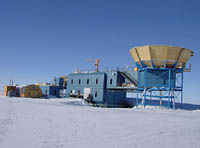|
|

|
|

|
Telescopes
used to study cosmic radiation are housed at the Center
for Astrophysical Research. Click to enlarge.
|

|
|
|
|

|
|
Welcome
to the South Pole
p.2
|

|
The
absence of water vapor in the winter skies above the South
Pole is the reason why many cosmologists flock to this harsh
place to do their work. Here, they can search the farthest
reaches of space for the afterglow of the Big Bang, which
is blocked by water vapor in the atmosphere. The
Big
Bang
was a catastrophic explosion that created the universe
some 14 billion years ago. As the expanding universe cooled,
elementary particles condensed to form the first light elements,
hydrogen and helium, and released a cloud of radiation still
visible today as the cosmic microwave background (CMB). Temperature
fluctuations in the CMB in turn reveal the origins of planets,
stars, and galaxies that started forming 300,000 years after
the Big Bang.
The cosmic microwave background is being studied using two
telescopes at the Center for Astrophysical Research in Antarctica.
Both the DASI and the VIPER telescopes are creating some of
the first fine-scaled maps of the very early universe. To
map the sky, the VIPER telescope houses an instrument called
ACBAR (Arcminute Cosmology Bolometer Array Receiver) co-designed
by Professor Bill Holzapfel of the University of California
at Berkeley.
ACBAR measures minute temperature differences in the CMB.
To do that, the instrument has to be cooled to just above
absolute zero (-273). The South Pole in winter is cold, it
can get to –100 degrees Fahrenheit here, but not cold
enough. To cool the instrument even further, ACBAR is housed
within a thermos that is itself nested in a thermos and cooled
using liquid helium. With this supercool instrument, Bill’s
group hopes to continue mapping the fine details of the background
radiation and to study galaxy clusters from deep space.
The last stop on our tour was the "clean sector"
where the world’s most pure air blows across a thousand
miles of empty ice on the polar plateau. Upwind of the South
Pole station, the National Oceanic and Atmospheric Administration
built a lab to study global changes in the earth’s atmosphere
and continued a long tradition of studying weather and the
atmosphere dating back to 1957.
NOAA’s
South Pole observatory
was one of the first sites to measure
the thinning of the ozone layer in the upper atmosphere over
Antarctica and the southern tip of South America.
Ozone helps block UV radiation from reaching the surface of
the earth, protecting living organisms from damaging radiation.
In the early spring, this ozone layer is partially eaten away
by atmospheric pollutants called chloroflurocarbons (CFCs)
that drifted there from human sources on the surface. By mid-summer,
the ozone layer thickens up again but not before it can start
damaging living cells (an increase in skin cancer in Chile,
Argentina and New Zealand has been attributed to ozone thinning).
Scientists continue to monitor the ozone layer from Antarctica,
and levels of CFCs have been dropping after an international
treaty was signed in 1987 that curbed their production. But
it might be another decade or more for these pollutants to
clear from the stratosphere and for the ozone hole to disappear.
The South Pole is also an ideal place to study the concentration
of carbon dioxide and other greenhouse gases and how they
might contribute to global warming. Because there are few,
if any, sources of carbon dioxide on the polar plateau, this
is a barometer for measuring whether the global concentrations
of these gases are increasing. Posters on the wall show a
clear and steady trend of increasing CO2 levers from 1957
to the present. Although it’s hard to really understand
how increased greenhouse gases and global warming will affect
life on earth when you’re exposed to temperatures well
below freezing, this research is vitally important to understanding
how human activity can impact world climate. It’s also
a wonderful place to stare out the window at the most expansive
and empty landscape I’ve ever seen.
|

